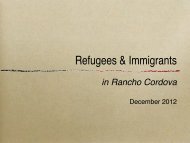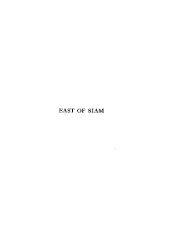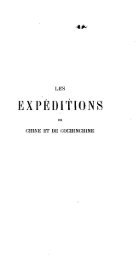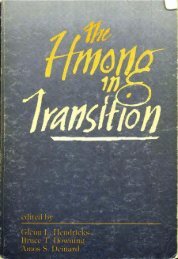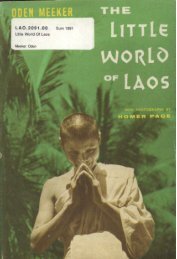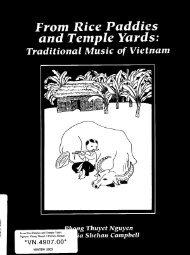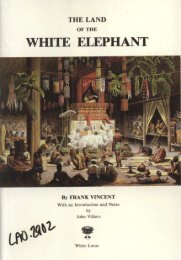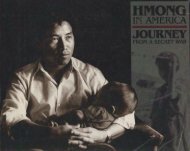PEOPLE
Grant, The Boat People - Refugee Educators' Network
Grant, The Boat People - Refugee Educators' Network
- No tags were found...
You also want an ePaper? Increase the reach of your titles
YUMPU automatically turns print PDFs into web optimized ePapers that Google loves.
A d a<br />
How many boat ptople pcrished in the four years or so to<br />
middle of 19793 One of the most often quoted figures is up to<br />
per ccnt. In June 1978, the US assistant xcretary of state for €8<br />
Asian and Pacific affain, Richard Holbroke, said in a speech<br />
many refugees 'set out in rickety boats with few supplies, and<br />
mmtcs art that only half make it to another port'. Australia's mint<br />
for immigration, Michael MacKellar, said sevml times be^<br />
April and July 1979, that about half the boat people perished<br />
He wid this conclusion was drawn from talks with refuge<br />
intelligence sources. We are looking at a death rate of be<br />
100 000 and 200 000 in the last four years'.<br />
Some estimates ranged even higher. They concentrated on w<br />
was undoubtedly the special horror, and susceptibility to mishap<br />
the boats ,that brought tens of thousands of Chinese from south<br />
Vietnam after March 1978. These wdcn vessels wcre scld<br />
suited for a sea pawge and often grossly overloaded, often ha<br />
as many as 600 or 700 men, women and children crammed into<br />
or three layen below deck. The passengers were virtually entom<br />
amid the noise and fumes of the engine, and the dreadful pres<br />
human bodies, for as long as the voyage lssted. Air was forced i<br />
the holds through funnels from the deck.<br />
In July 1979, the US state department handed a 'dossier'<br />
journalists alleging Vietnamese government complicity in the ex<br />
of refugee^. One of the documents appended to this report qu<br />
comments of 'a western observer in Hanoi' to the effect that Chi<br />
in Viemam estimated that about 70 per cent of refugees wcrc n<br />
being lost at sea. This high rate of loss was attributed to the u<br />
smaller and less senworthy vessels, compounded by the use of 5<br />
diesel engines, originally imported for light work in the: delta wa<br />
which wcre breaking duwn or exploding during thc lung<br />
journeys,<br />
We know that 292 315 pcople who left by boat from Victna<br />
between May 1975 and mid-1979 reached other countrica. Rut no 4<br />
one knows, although Vietnamese authorities may have a rough id<br />
how mny people actually set out in boats. Nonethclcss, rstima<br />
of an overall death rate of 50 per cent, or wen higher, appear to be<br />
exsggcrated. On the basis uf the numbers that arrived, this woul<br />
have meant a figure of nearly I50 000 lost.<br />
1<br />
Refugee officials and thost knowledgeable about conditions at<br />
*a, agree that the casualty rate among boat people heading for Hong<br />
Kong was low, Unlike the southern route from Viemam, the way<br />
to Hong Kong was not beset with pirates. Moreover, even though<br />
many of the boats th~t<br />
crept towards Hang Kong were powered only<br />
by sail, they stuck close to the const of China and $0 could escape<br />
bad weather and stock up on essential supplies. The refuges in<br />
Hong Kong constituted a sizeable proportion uf the total exodus -<br />
77090 out of 292 315.<br />
Also, many of those boat people forced out to sea, especially by<br />
Malaysia, managed to sneak back. There are documented cases of<br />
at least 500 drownings as a result of Malaysian policy, bur it is clear<br />
that the overwhelming proportion of more than 40000 Indo-<br />
Chinese towed out to sem by the Malaysian navy in the fmt six<br />
munths of 1979 returned to Malaysia or landed in Indonesia, Many<br />
of the boats were towed to within a few hours sailing of Indonesia's<br />
Annmbas Islands, By the end of July, there were 33 000 Indo-<br />
Chinese in camps in these islands, virtually all of them rejected by<br />
Malaysia. Only for a period of a few wceke around mid-1979 was<br />
the Malaysian navy known to be towing rcfugee boats straight out<br />
into the South China Sea, rather than towards Anamhas or other<br />
islands of the Indonesian archipelago.<br />
Spokesmen for western governments, such as those of the United<br />
States and Australia, may have felt it politic m heighten the tr~gedy<br />
uf the boat pople in order to generate international sympathy for<br />
thc refugees and win domestic support for rescttlemcnt programs.<br />
They may also have wanted to blacken Vietnam's already tarnished<br />
image on the human rights issue and, perhaps, justify their own policies<br />
of hostility to communist Vietnam.<br />
However, the diffcrencw betwen several and many thousands,<br />
while reducing the scale of the tragedy, does not diminish its force.<br />
Vl'hilc dismissing as excessively inflated claims of a 50 per cent death<br />
rate among boat people, one experienced western official said he<br />
hclicved drat between ten and fiftecn pcr cent of refugees leaving<br />
Vietnam on small boats were lost at sea. This means that some 30 000<br />
to 40 OCK) pcople died.





